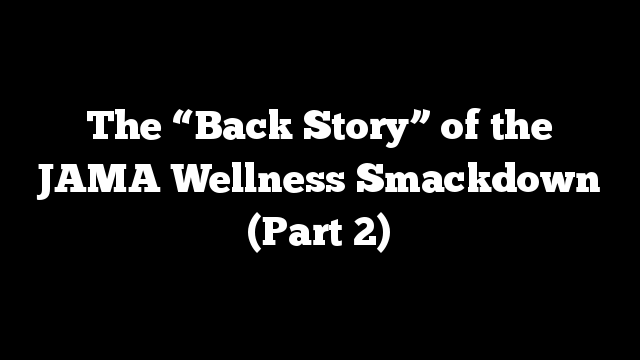
By AL LEWIS
Part 2 picks up where Part 1 left off, as coincidence would have it.
Soeren Mattke (as mentioned in the last installment) and I were quite relentless in trying, quixotically, to get Professor Baicker to explain her results. Its popularity could have landed her many profitable speaking and consulting gigs, but she evinced no interest in cashing in, or even in defending her position. Indeed, the four times she spoke publicly on the topic, she didn’t do herself, or her legions of sycophants in the wellness industry, any favors. In each interview, she distanced herself more and more from her previous conclusion. Here are her four takeaways from her own study “proving” wellness has precisely a 3.27-to-1 ROI:
- It’s too early to tell (um, after 30 years of workplace wellness?)
- She has no interest in wellness anymore
- People aren’t reading her paper right (Shame on us readers! We’re only reading the headline, the data, the findings and the conclusion, apparently)
- “There are few studies with reliable data on the costs and the benefits”(um, then how were you able to reach a conclusion with two significant digits?)
Individually or in total, these comments sounded an awful lot like retractions, but she (and her co-author and instigator, David Cutler) claimed those comments didn’t constitute retractions. Whatever they were, she wasn’t exactly doubling down on this 3.27-to-1 conclusion.
The industry at this time — 2013 and 2014 — came under a lot of criticismfor basically being somewhere between hilariously worthless and a fraud. (Here is some comprehensive documentation of the fraudulent and harmful activity in the wellness industry. Wellness is a classic example of the observation that every cause starts out as a movement, becomes a business, and degenerates into a racket, the poster company for the last being Interactive Health.)
Here’s where it gets interesting. Due to this relentless criticism, instigated and sometimes written by me (most of which is catalogued here) with credit to Soeren Mattke and Jon Robison as well (with Pulitzer Prize-winning LA Times columnist Michael Hiltzik piling on multiple times), Ron Goetzel and his colleagues urged Professor Baicker — who had previously claimed to have no more interest in wellness — to get a grant from Ron’s friends at the Robert Wood Johnson Foundation and do an actual controlled study of workplace wellness to set the record straight. As a strategic gambit, this showed a level of professional judgment worthy of Gary Hart.*
Obviously if you are perpetrating a fraud and you know it, you don’t urge people to investigate it. Mr. Goetzel at this point (or at least shortly thereafter) knew that his industry was a fraud, going so far as to erase some accurate data and disown inconveniently accurate conclusions he had forgotten to suppress.
He even forged a letter from the governor of Nebraska to cover his tracks. (To be completely accurate, he did not forge the signature on the letter. He merely doctored the wording in a letter that was already signed to say something much different than the letter said when it was actually signed. Maybe that’s not technically forgery. Who knows?)
And yet that’s exactly what Mr. Goetzel did. Maybe he thought she was as corrupt as he is, but she has an excellent reputation in this industry. My suspicion is that she accepted his offer for exactly the opposite reason that he made it — to clear her name after her ill-considered 2010 meta-analysis.
Way back in 2016, I predicted how this gambit would turn out — that Katherine Baicker was not going to mail it in this time but rather do a high-quality study of the type she is known for.
Her now-famous outcome was preordained for four reasons:
- In this industry, as Michael O’Donnell pointed out in the trade journal where he formally served as Prevaricator-in-Chief, the higher quality the study, the lower the ROI, to the point where RCTs invariably show negative ROIs. (Owing to the embarrassing accuracy of this unintended finding, Mr. O’Donnell walked it back in a subsequent editorial.)
- Kate Baicker was not going to sully her legacy by being known as the Typhoid Mary of wacky wellness programs, just to please her sycophants.
- She picked the most clueless vendor imaginable to carry their water. This selection couldn’t have been an accident.
- No wellness study since Johnson & Johnson (which was probably also wrong–just not obviously from the data presented) had shown even a remotely positive outcome. This list includes PepsiCo, Barnes Hospital, Nebraska, Vitality, Newtopia, Health Fitness Corp, Health Fitness Corp again, Boise School District/Wellsteps, McKesson, Connecticut, and the University of Illinois. All were epic fails, according to their own data. Not to mention that the wellness trade association itself published a case study showing wellness loses money and then ran away from it.
Where does the wellness industry go from here? They’re hoping for Tiger Woods, wiser souls are channeling Gary Hart, and probably what we’ll get instead is Harold Stassen. (Look it up.)
*For those of you who aren’t old enough to remember, here’s what happened. Dogged by rumors of philandering, the front-running Democratic presidential candidate urged reporters to follow him around. It took about a day for reporters to discover he was indeed philandering. It only took another few weeks for him to withdraw from the presidential race.
Al Lewis, the originator of risk-based population health contracting and outcomes measurement, is founder and President of the Disease Management Purchasing Consortium International, Inc. This article originally appeared on Dismgmt here.
